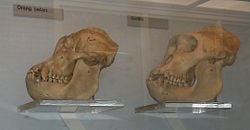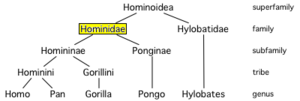The Family Hominidae Includes Which of the Following Taxa?
| Hominids[one] | ||||||||||||||||||
|---|---|---|---|---|---|---|---|---|---|---|---|---|---|---|---|---|---|---|
 Australopithecus africanus reconstruction | ||||||||||||||||||
| Scientific classification | ||||||||||||||||||
| ||||||||||||||||||
| | ||||||||||||||||||
|
Hominidae is a taxonomic family unit of primates that today is commonly considered to include extant (living) and extinct humans, chimpanzees, gorillas, and orangutans. In this taxonomic scheme, Hominidae is ane of two families of apes (superfamily Hominoidea), the other family being Hylobatidae (the gibbons). Members of Hominidae (sometimes exclusive of humans) are known every bit the "great apes," while members of Hylobatidae are known as the "lesser apes."
Yet, historically, and even in some current taxonomic schemes, Hominidae included only humans and their close extinct relatives (eg., Australopithecines, Neanderthals)—that is, those more closely related to humans than the other great apes, which were in a different family.
The use of the term hominid, which is the designation for members of Hominidae, reflects these two meanings. In a technical and growing sense, it refers to humans, chimpanzees, gorillas, and orangutans and their extinct relatives. Yet, also common, particularly in anthropology, is to encounter hominids refer merely to humans and their extinct forebears, both because of historical tradition and considering of taxonomies in which humans are the only extant species in Hominidae.
The historical view of humans as unique from the rest of living organisms has gradually been eroded, culminating with the placement of humans together with the bang-up apes in the same family Hominidae, on the basis of quite similar morphological and genetic characteristics. There are even proposals to place gorillas and chimpanzees together with humans in the Homo genus and to consider smashing apes as "persons." Indeed, chimpanzees and humans share more than than 98 percent genetic similarity. However, when other factors are considered, the gap between humans and the residual of living organisms, including primates, is great indeed. Only humans have circuitous language using syntax and grammar, circuitous social systems (forms of government, etc.), and complex technologies ( computers, satellites, etc.). Human creativity is such that people even develop new varieties of plants and breeds of animals.
Overview
The classification of Hominidae has been revised several times in the last few decades. Originally, Hominidae included only humans and their extinct relatives, with all other apes beingness placed in a carve up family, the Pongidae (Simpson 1945). In the 1960s, utilizing techniques from molecular biological science, the lesser apes were moved into their own family unit (Hylobatidae), with humans remaining in Hominidae, and the non-human great apes remaining in Pongidae.

Skulls of an orangutan and a gorilla
Somewhen, the other cracking apes (gorillas, orangutans, and chimpanzees) were placed into the family unit Hominidae along with humans, by demoting the Pongidae to a subfamily. Subsequently, it was decided that the African apes (chimpanzees and gorillas) were more closely related to each other than any of them are related to the organgutans, and the chimpanzees and gorillas were moved into the subfamily Homininae with humans, with orangutans remaining in the subfamily Pongidae. Chimpanzees and humans were further separated into the aforementioned tribe, Hominini, and humans and their extinct relatives further separated into the sub-tribe Hominina.
Based on this scenario, the following terminology would be technically correct:
- A hominid is a member of the family Hominidae: All of the bang-up apes, including humans.
- A hominine is a fellow member of the subfamily Homininae: Gorillas, chimpanzees, humans (excludes orangutans).
- A hominin is a member of the tribe Hominini: Chimpanzees and humans.
- A hominan is a member of the sub-tribe Hominina: Humans and their extinct relatives.
Withal, universal credence of this taxonomy of Hominidae is defective and thus affecting the consensus of the term "Hominid." Certain characteristics are notwithstanding used past some systematics to support the idea that hominid should only announce humans and homo ancestors. Some taxonomies place gorillas and chimpanzees (and the related bonobos) into the Panidae family, while orangutans remain in the Pongidae family, and humans in the Hominidae. Others continue to list only humans as hominids, and use a separate family, Pongidae, for smashing apes.
As noted in a higher place, anthropologists usually use the term hominid to refer only to humans and their direct and near-direct ancestors, based on many decades of utilise where hominid was used in that narrow sense.
On the other paw, some researchers become so far every bit to include chimpanzees and gorillas in the genus Homo along with humans, though this is uncommon.
Many extinct hominids (in the more inclusive sense) have been studied to assistance understand the relationship between modernistic humans and the other extant hominids. Some of the extinct members of this family include Gigantopithecus, Orrorin, Ardipithecus, Kenyanthropus, and the australopithecines Australopithecus and Paranthropus.
Nomenclature

- Family Hominidae: humans and other great apes; extinct genera and species excluded.
- Subfamily Ponginae
- Genus Pongo
- Bornean Orangutan, Pongo pygmaeus
- Pongo pygmaeus pygmaeus
- Pongo pygmaeus morio
- Pongo pygmaeus wurmbii
- Sumatran Orangutan, Pongo abelii
- Bornean Orangutan, Pongo pygmaeus
- Genus Pongo
- Subfamily Homininae
- Tribe Gorillini
- Genus Gorilla
- Western Gorilla, Gorilla gorilla
- Western Lowland Gorilla, Gorilla gorilla gorilla
- Cantankerous River Gorilla, Gorilla gorilla diehli
- Eastern Gorilla, Gorilla beringei
- Mountain Gorilla, Gorilla beringei beringei
- Eastern Lowland Gorilla, Gorilla beringei graueri
- Western Gorilla, Gorilla gorilla
- Genus Gorilla
- Tribe Hominini
- Genus Pan
- Mutual Chimpanzee, Pan troglodytes
- Fundamental Chimpanzee, Pan troglodytes troglodytes
- West African Chimpanzee, Pan troglodytes verus
- Nigerian Chimpanzee, Pan troglodytes vellerosus
- Eastern Chimpanzee, Pan troglodytes schweinfurthii
- Bonobo (Pygmy Chimpanzee), Pan paniscus
- Mutual Chimpanzee, Pan troglodytes
- Genus Homo
- Human, Human sapiens sapiens
- Genus Pan
- Tribe Gorillini
- Subfamily Ponginae
In improver to the extant species and subspecies above, archaeologists, paleontologists, and anthropologists have discovered numerous extinct species. The list below are some of the genera of those discoveries.
- Subfamily Ponginae
- Gigantopithecus
- Sivapithecus
- Lufengpithecus
- Ankarapithecus
- Ouranopithecus
- Subfamily Homininae
- Man—Humans and their immediate ancestors
- Oreopithecus
- Paranthropus
- Australopithecus
- Sahelanthropus
- Orrorin
- Ardipithecus
- Kenyanthropus
Notes
- ↑ Groves 181-184
References
ISBN links support NWE through referral fees
- Goodman, M. 1963. Homo's place in the phylogeny of the primates equally reflected in serum proteins. In Due south. L. Washburn, Classification and human evolution. Chicago: Aldine.
- Goodman, 1000. 1974. Biochemical testify on hominid phylogeny. Almanac Review of Anthropology three: 203–228.
- Goodman, 1000., D. A. Tagle, D. H. Fitch, W. Bailey, J. Czelusniak, B. F. Koop, P. Benson, and J. L. Slightom. 1990. Primate evolution at the DNA level and a classification of hominoids. Journal of Molecular Development thirty: 260–266.
- Simpson, Chiliad. G. 1945. The principles of classification and a classification of mammals. Bulletin of the American Museum of Natural History 85: 1–350.
Credits
New Globe Encyclopedia writers and editors rewrote and completed the Wikipedia article in accordance with New World Encyclopedia standards. This article abides by terms of the Creative Commons CC-by-sa 3.0 License (CC-by-sa), which may exist used and disseminated with proper attribution. Credit is due under the terms of this license that can reference both the New Globe Encyclopedia contributors and the selfless volunteer contributors of the Wikimedia Foundation. To cite this article click here for a list of acceptable citing formats.The history of earlier contributions by wikipedians is attainable to researchers here:
- Hominidae history
The history of this article since it was imported to New World Encyclopedia:
- History of "Hominidae"
Annotation: Some restrictions may apply to employ of individual images which are separately licensed.
Source: https://www.newworldencyclopedia.org/entry/hominidae
0 Response to "The Family Hominidae Includes Which of the Following Taxa?"
Post a Comment